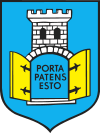Gołańcz
Gołańcz [ˈɡɔwaɲt͡ʂ] (German: Gollantsch) is a town in Wągrowiec County, Greater Poland Voivodeship, Poland, with 3,349 inhabitants (2004). The name was also spelled Gollanz or Gollantsch in Prussian times.
Gołańcz | |
|---|---|
Gołańcz railway station | |
 Coat of arms | |
 Gołańcz | |
| Coordinates: 52°56′54″N 17°18′5″E | |
| Country | |
| Voivodeship | Greater Poland |
| County | Wągrowiec |
| Gmina | Gołańcz |
| Area | |
| • Total | 12.63 km2 (4.88 sq mi) |
| Population (2006) | |
| • Total | 3,342 |
| • Density | 260/km2 (690/sq mi) |
| Postal code | 62-130 |
| Website | http://www.golancz.pl/ |
During the First Partition of Poland in 1772, the town became part of the Kingdom of Prussia. It briefly belonged to the Duchy of Warsaw, but again became part of Prussia following the Congress of Vienna in 1815. After the First World War, the town became part of the Second Polish Republic in 1919 following the Greater Poland Uprising. It was again annexed by Germany as a result of the joint German-Soviet invasion and partition of Poland in 1939 and was restored to Polish rule in 1945, albeit under Soviet occupation during the existence of the Polish People's Republic.
The prominent British Jewish family of Gollancz originated in this town. Through Victor Gollancz, the town has indirectly given its name to several streets in Germany, including the Gollanczstraße in West Berlin.
Notable residents
- Salomo Friedlaender (1871 – 1946), German philosopher